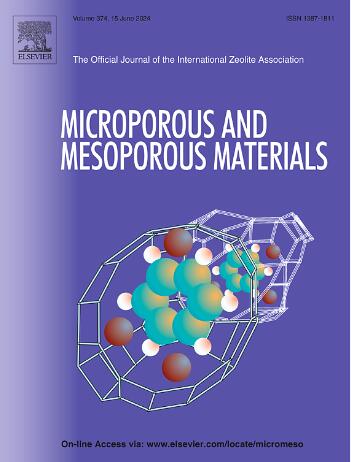Ammonia-assisted dry-gel conversion for preparation of TS-1 with enriched Ti(OSi)3OH active sites
IF 4.8
3区 材料科学
Q1 CHEMISTRY, APPLIED
引用次数: 0
Abstract
Defective Ti(IV) species, i.e. Ti(OSi)3OH, are highly active catalytic sites within the TS-1 framework, and developing efficient methods to enrich these species has attracted significant attention from both academia and industry sectors. Herein, we developed an ammonia-assisted dry-gel conversion (DGC) method to synthesize TS-1-AM enriched with Ti(OSi)3OH species using NH3 (ammonia, AM) as a modifier. Comprehensive characterization using XRD, UV–Vis, SEM, XPS, pyridine-IR, solid-state MAS NMR confirmed the abundant presence of Ti(OSi)3OH species in TS-1-AM. The modified catalyst demonstrated exceptional performance in alkene epoxidation, achieving approximately 150% higher catalytic activity compared to the parent TS-1, while maintaining excellent cycling stability. Further studies revealed that the synergistic effect of NH3 and H2O molecules facilitated the selective cleavage of framework Si-O-Ti bonds, promoting the conversion of Ti(OSi)4 species to Ti(OSi)3OH species. Furthermore, the condensation of surface silica hydroxyls, particularly silica hydroxyl nests, enhanced surface hydrophobicity. This straightforward DGC method provides an efficient approach for synthesizing titanosilicates enriched with highly active Ti(OSi)3OH species.

氨辅助干凝胶转化制备富Ti(OSi)3OH活性位点TS-1
缺陷Ti(IV)物种,即Ti(OSi)3OH,是TS-1框架内的高活性催化位点,开发有效的富集这些物种的方法引起了学术界和工业界的极大关注。本研究采用氨辅助干凝胶转化(DGC)方法,以NH3(氨,AM)为改性剂,合成了Ti(OSi)3OH富集的TS-1-AM。通过XRD、UV-Vis、SEM、XPS、吡啶- ir、固态MAS NMR等综合表征证实了TS-1-AM中存在丰富的Ti(OSi)3OH物质。改性后的催化剂在烯烃环氧化反应中表现出优异的性能,与母体TS-1相比,催化活性提高了约150%,同时保持了良好的循环稳定性。进一步研究发现,NH3和H2O分子的协同作用促进了框架Si-O-Ti键的选择性裂解,促进了Ti(OSi)4向Ti(OSi)3OH的转化。此外,表面二氧化硅羟基的缩合,特别是二氧化硅羟基巢,增强了表面疏水性。这种简单的DGC方法为合成富含高活性Ti(OSi)3OH的钛酸盐提供了一种有效的方法。
本文章由计算机程序翻译,如有差异,请以英文原文为准。
求助全文
约1分钟内获得全文
求助全文
来源期刊

Microporous and Mesoporous Materials
化学-材料科学:综合
CiteScore
10.70
自引率
5.80%
发文量
649
审稿时长
26 days
期刊介绍:
Microporous and Mesoporous Materials covers novel and significant aspects of porous solids classified as either microporous (pore size up to 2 nm) or mesoporous (pore size 2 to 50 nm). The porosity should have a specific impact on the material properties or application. Typical examples are zeolites and zeolite-like materials, pillared materials, clathrasils and clathrates, carbon molecular sieves, ordered mesoporous materials, organic/inorganic porous hybrid materials, or porous metal oxides. Both natural and synthetic porous materials are within the scope of the journal.
Topics which are particularly of interest include:
All aspects of natural microporous and mesoporous solids
The synthesis of crystalline or amorphous porous materials
The physico-chemical characterization of microporous and mesoporous solids, especially spectroscopic and microscopic
The modification of microporous and mesoporous solids, for example by ion exchange or solid-state reactions
All topics related to diffusion of mobile species in the pores of microporous and mesoporous materials
Adsorption (and other separation techniques) using microporous or mesoporous adsorbents
Catalysis by microporous and mesoporous materials
Host/guest interactions
Theoretical chemistry and modelling of host/guest interactions
All topics related to the application of microporous and mesoporous materials in industrial catalysis, separation technology, environmental protection, electrochemistry, membranes, sensors, optical devices, etc.
 求助内容:
求助内容: 应助结果提醒方式:
应助结果提醒方式:


